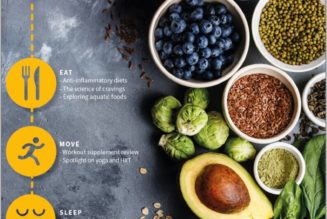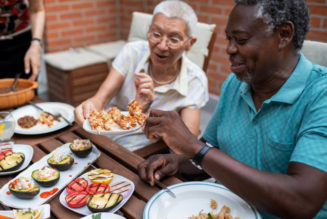
This study applied a theoretical framework to examine capabilities, opportunities, and motivation associated with healthier eating behaviors in LARs, an understudied, yet increasingly important community food source. The application of the COM-B model allows a systematic exploration of behavior, in this case, a range of behaviors associated with selecting healthier foods at LARs. The examination revealed that, while interventions may be needed across all areas of the COM-B, there is a pressing need to address physical and social opportunities, as the domains found most lacking among the respondents, to make a strong impact on these LAR environment healthy eating behaviors. Physical opportunity is having an environment that affords the time, resources, location, and other physical affordances associated with the desired behavior. The association between food environments and healthier food consumption has been documented [16], noting linkages between healthful environments and cardiovascular disease risks [17]. In this study, we focused on the availability of appealing healthy options that are also affordable and in adequate portions. While food environment research to date underscores the need to increase availability and accessibility of healthy options, this paper illustrates the importance of norms and notions associated with foods. These factors are captured under the social opportunity domain, referring to interpersonal influences and sociocultural norms that enable the desired behavior [8]. Social norms can influence food consumption via peer influence and also by changing perceptions of certain foods, with the potential for making healthier options more appealing [18, 19]. In restaurant setting, social perceptions concerning establishment types have the potential to influence food choices, regardless of actual food availability. For instance, notions of fast food restaurants as places for junk food consumption have been associated as a barrier for healthy eating at these establishments [20]. Moreover, research has also started to examine the role of hedonic descriptions to motivate healthier food consumption in restaurant menus [21].
The application of the COM-B as part of the larger, related intervention design framework – the Behavior Change Wheel Model – allows for the identification of potential intervention functions to promote desired changes. Physical and social opportunity can be enhanced via environmental restructuring, restriction, and enablement. These changes imply interventions beyond individual-level strategies and the importance of changing consumer nutrition environments in LARs, not only by increasing the variety of healthier food options, but also by enabling healthier choices through, for example, menus highlights. Emerging evidence from restaurant intervention studies suggests that restaurants that increase the availability of healthier options and enable healthier choices can result from increased consumption [cite/expand]. These changes can also boost social opportunity, showcasing healthy options through innovative approaches that not only underscore the health benefit of these choices but also showcases these healthier options as traditional and palatable. While most interventions, to date, have focused on augmenting physical opportunity, more attention is needed to address social norms concerning healthier foods. These approaches can help increase interest in these offerings, while also normalizing these healthier options in the community, which, in turn, can help foster changes in social and cultural norms about which foods customers should expect to find in these establishments.
Our study’s operationalization of the COM-B model facilitated a statistical analysis to examine demographic characteristics associated with having the capabilities, opportunities, and motivations necessary to engage in healthier eating behaviors at LARs. Age and race were consistently associated across all domains, except for psychological capability. The results suggest that younger customers may have more social opportunity, motivation, and skills (physical capability) to engage in healthier eating behaviors at LARs. This corroborates previous research showing greater interest in healthier eating among younger generations [22]. On the other hand, older age was associated with physical opportunity, which may point to age-related differences in perceived physical and economic access to healthy choices in LARs.
The significant association with race shows the potential racial inequities in facilitators for healthier choices in LARs. While most studies tend to examine race and ethnicity, incorporating “Hispanic/Latino” as a category, our study examined race and Latin heritage separately, allowing for a more nuanced exploration of these demographic characteristics. Our results suggest that self-identifying as white was associated with more COM-B domains, compared with having Latin heritage. These findings showcase the importance of examining racial differences among Latin/Hispanic communities, an important research need documented in past research [23].
Gender was associated with higher psychological capability and motivation. This coincides with research that examines gender difference in interest in healthy eating behaviors. In restaurant settings, women tend to worry more about the caloric content of foods, compared to men [24]. Healthier foods, like vegetables, fruit, and fish, are typically associated with femininity, and women are usually more aware of the health-diet relationship than men [25]. Research examining food purchasing behaviors by gender is scarce, and it suggests that men tend to consume more foods away from home, compared with women, but no significant differences in diet quality were found [26]. More research is still needed to elucidate gender differences, including more studies that focus on men and gender minorities.
Variables associated with socioeconomic status (income and education) did not show associations across most COM-B domains. Income was only significantly and positively associated with total COM-B score. Higher education was only significantly associated with greater psychological capability (knowledge). Hence, while socioeconomic factors have been documented as important factors associated with diet quality [27, 28], economic access appears to be only one part of the story for food choices in restaurant settings. However, more research is needed to elucidate differences in food consumption in restaurants by socioeconomic characteristics, building on emerging work examining dietary intakes by food source [29].
Lastly, we found that residence in a state with an above average percentage of Latin population, was significant only for the total COM-B score and social opportunity. We expected to find that a higher proportion of Latin/Hispanic population may result in higher exposure to LARs and Latin food in markets [30], and that this exposure may, in turn, influence aspects of the COM-B, such as through increased knowledge of Latin foods or greater social opportunity, for example. Our results suggest some association, but more research is needed. Our research was limited, as we assessed Latin/Hispanic population at the state level, which fails to capture neighborhood-level concentrations – an approach that can be explored in future research. While research documents the potential benefits of ethnic enclaves through greater availability of relevant cultural institutions, like restaurants, more work is needed to assess how such restaurants may be perceived by others in the area. Recent work examining how immigrant-run food establishments are perceived show different results, where in some cultural diversity in food store availability is viewed as a positive [31], whereas in another work these establishments are perceived to be of lower quality [32]. However, more research is still needed to examine potential associations between the availability of ethnic restaurants and food choices.
The present assessment applied the COM-B in a complex, community-based setting, moving this area of research beyond mostly clinical settings and qualitative approaches in past studies. However, there are some limitations in the study. First, our measures were based on self-reports which might be biased by social desirability. Second, to keep the scale short, some aspects of the COM-B, particularly the capability measures, were assessed with only one item. In addition, knowledge was assessed through an open-ended question because we wanted to capture consumers’ interaction with a rich diversity of offerings in complex LAR settings. Future research is warranted to further validate and refine the survey tool. Third, while this study enhanced our understanding of demographic group differences in COM-B, future research should extend the research to objective measures of restaurant purchases and consumption as well as the consideration of other factors that influence eating behaviors at restaurants, such as prices, type of eating occasion, presence of others, and type of restaurant. Finally, our findings are not generalizable to the larger population. However, the distinct associations found in this initial assessment suggest that this may be a promising assessment for aiding in targeting interventions.









